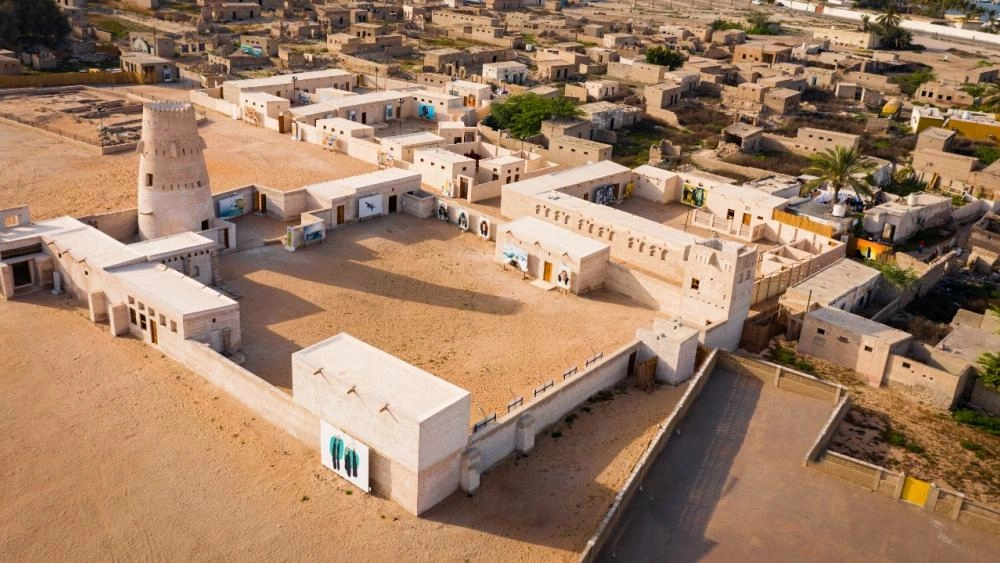The competent authorities in Ras Al Khaimah are working to launch the “Culture and Heritage Vision 2030”, as part of joint efforts that include the Ras Al Khaimah Tourism Development Authority, the Department of Antiquities and Museums, the Sheikh Saud bin Saqr Al Qasimi Foundation for Policy Research, and “Marjan”, the main developer of freehold projects in Ras Al Khaimah. The comprehensive plan has identified 20 heritage sites in the emirate, to be preserved and developed in a sustainable manner, to gain special importance.
Raki Phillips, CEO of the Authority, explained to “Al Khaleej” that these sites include prominent landmarks and monuments that have been included in the tentative list of UNESCO World Heritage Sites. The most prominent of these are Dhayah Fort, the last hilltop fort in the UAE, and Al Jazirah Al Hamra Village, the last pearl fishing village in the Arabian Gulf region.
Landmarks include the Shamal area, which includes more than 100 prehistoric tombs and settlements, and a medieval palace, as well as Julfar, the only port in the Gulf, from which ships set sail to the southeast of the Arabian Peninsula, from before the Islamic era until the 18th century. Phillips pointed out that the tourism sector in Ras Al Khaimah currently represents 5% of the emirate’s gross domestic product, while the emirate aims to increase its contribution to the emirate’s economy to a third, and attract 3.5 million visitors annually, by 2030, with cultural tourism forming the main pillar of achieving these goals, providing an ideal opportunity to link the ancient past with a promising future, while preserving the emirate’s cultural identity and historical legacy.
Phillips stressed that the world is witnessing rapid economic growth, which contributes to the redevelopment of tourist destinations. While modernity and urban expansion may sometimes overwhelm historical landmarks and their cultural identity, achieving a balance between the march of progress and preserving cultural and historical sites is more important than ever, pointing to the growing interest of travelers in searching for distinctive experiences that focus on the historical value of the places they visit and learning about the traditions and cultures of their people. According to the World Tourism Organization, cultural tourism represents about 40% of total tourism revenues worldwide and is expected to achieve an annual growth of 4.1% until 2030.
Phillips explained: Cultural tourism is capable of achieving sustainable value, while ensuring the protection of the environment and cultural heritage in the long term, and has proven its ability to adapt to challenges and changes through sound planning and cooperation with relevant parties. An important question arises: How can tourist destinations balance, through modern infrastructure, between preserving their cultural heritage and developing their tourism scene. Balancing heritage preservation and tourism development requires wise management and a strategic vision, as historical and heritage sites may be at risk of deterioration in the absence of careful coordination within development processes. These tourist destinations must conduct comprehensive assessments of environmental and cultural impacts before starting any development projects.
The CEO of the Authority stressed that Ras Al Khaimah has a long history spanning thousands of years, as its beaches, sands and mountains have witnessed multiple civilizations that have succeeded each other for more than 7,000 years. The emirate is distinguished by its rich cultural diversity, which includes many historical landmarks, such as the old commercial port of Julfar and the historic Dhaya Fort, which is a witness to the history of Ras Al Khaimah. He said: “Recognizing the importance and value of its cultural heritage, preserving these heritage sites requires continuous coordination with experts in the fields of archaeology and history, and adopting sustainable practices that are consistent with the goals of global ecotourism, to ensure the preservation and protection of the authenticity of historical heritage.”
He stressed that Al Jazirah Al Hamra village in the emirate is a living example of the importance of commitment to preserving heritage, as it represents an authentic symbol of the Emirati heritage, and reflects the social and economic scene in Ras Al Khaimah. In the past, the island was a vital center for diving and trade, and its architectural structures, made of coral and mud bricks, are still a testament to the engineering ingenuity, which was designed to withstand the harshness of time and the challenges of nature.
The Al Zaab tribe was the first to inhabit Al Jazirah Al Hamra, in the late sixteenth century, when it was a tidal island divided into two parts: the northern part known as “Umm Awimer”, and the southern part known as “Manakh” district. They established a village where life flourished, thanks to pearl diving activities, along with fishing and trade. By the early twentieth century, the village had expanded to include about 45 hectares, where it included about 500 homes, and its population was estimated between 2,500 and 3,000 people. Phillips explained: The village preserves all the elements of traditional Emirati heritage life, and includes a towering fort, watchtowers, mosques, a market, and spacious traditional Emirati houses, with different designs that reflect the diversity of social life.
Phillips said: Restoration efforts focused on preserving the traditional architectural character of the Emirati historical village, using natural materials, such as coral stone, mangrove wood, and sand bricks. As some of these materials are scarce or to protect them, sustainable alternative materials were used. He believed that preserving Al Jazirah Al Hamra Village is the result of joint efforts between local and international experts, as initial restoration work began in 2010, and focused on ensuring the structural integrity of the existing buildings, and protecting them from deterioration and collapse. Phillips added: “Al Jazirah Al Hamra” represents a vital cultural center, hosting a variety of art festivals, educational programs, and cultural events, which allow visitors the opportunity to directly interact with the history of the emirate.

